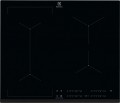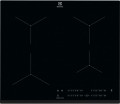Bridge mode
A function that allows you to combine two (or more) adjacent electric hotplates into one burner. Often, this mode is found in induction hobs, less often in Hi-Light, and is not used in gas hobs. Often the "bridge" looks like one continuous heater of an elongated shape, the individual parts of which can be turned on independently and are separate burners. Anyway,
the bridge mode (Bridge) can be useful primarily for working with elongated utensils — for example,
goose roasters. In addition, the design may provide various additional functions — for example, the ability to set different power settings for different parts of the "bridge" and move the dishes between them depending on the readiness of the dish. At the same time, unlike conventional burners, the heating will turn on automatically, according to the presence of dishes on the burner.
Burners power
Nominal burners power. It refers to the power consumption of the heater. This parameter allows you to estimate how much electricity the burners will spend when operating at maximum heating intensity. At the same time, the heat transfer power of different burners can be different, and the actual heating efficiency will also greatly depend on the specs of the dishes. As a result, it hardly makes sense to evaluate the working capabilities of the hob by the power of the burners. It is quite possible to proceed from the fact that the burner will be enough for a pot of the same diameter.
Burner diameter
The heating power directly depends on the diameter of the burners. And, at the same time, the performance of the device and the speed of cooking. The larger the burner, the more heat dissipation it has. Also, the diameter of the burner allows you to determine what sizes of dishes are suitable for use on the hob. Indeed, for induction models, this value is critical for high-quality heating. Burners can have the following diameter:
- small — about 145 mm, power within 1200 W;
- medium — about 180 mm, power within 1700 W;
- large — about 220 mm and more, power within 2000 watts.
Some hobs use double ring burners that allow you to adjust the diameter of the heating zone. If the diameter of the burner is 180, 200, 220 mm, then it means that the heating zone on a particular burner can be narrowed or expanded, depending on the size of the dishes used.
Input power
The input power of the hob is the maximum electric power consumed during its operation. This parameter is indicated only for models that are equipped with at least one electric hotplate. It is electric burners that are the highest consumption in terms of energy consumption. Additional functions such as auto-ignition require little energy, and a regular outlet is enough for them.
First of all, the requirements for the power mains depend on this parameter: it must be able to provide such power without overloads. It is worth noting that for household sockets the power limit is about 3 – 3.5 kW, with more power, you need to connect the hob to 230 V mains according to special rules. An alternative is to use a three-phase 400 V mains: most modern hobs with electric burners allow connection to both 230 V and 400 V mains.
Country of origin
The country in which, according to the manufacturer, this or that model is manufactured. Despite the fact that most of the manufacturers are concentrated
in China, European factories for the production of household appliances have not disappeared. And certain models can be produced on them. In general, such a division into a Chinese or European plant should not particularly affect the quality of products, but still the stereotype of a reliable European assembly (
Germany,
Spain,
Italy,
Poland,
Turkey) is present in us. However, it is possible that the model may have a country of manufacture, for example, Poland, and in the store under the same article you will meet China.

